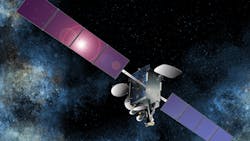Providing broadband services over parts of Central and Eastern Europe, the THOR (no relation to the Norse god) constellation is adding another satellite to the mix: THOR 7. Based on Space Systems/Loral’s (SS/L) LS-1300, the satellite has a total continuous power range from 5 to 12 kW with on-board transmitter power exceeding 5000 W. The high-throughput satellite (HTS) will help to meet the growing demand for maritime broadband services while providing strong signals over Europe’s main shipping routes and oil and gas exploration areas. Equipped with 25 spot beams, THOR 7 also marks Telenor Satellite Broadcasting’s (TSBc’s) first Ka-band payload.
This file type includes high resolution graphics and schematics when applicable.
This payload should be at least partially credited to the integration of iDirect’s Velocity product line, which will be used as the ground infrastructure solution. Across the 25 spot beams, the HTS payload will deliver up to 9 Gb/s of throughput over the North Sea, Norwegian Sea, Mediterranean, Persian Gulf, and Baltic Sea as well as the Middle East. THOR 7 is also equipped with 11 Ku-band transponders, facilitating inter-networking roaming with other Ku- and Ka-band satellite operators. As a result, end users should be able to travel outside their service providers’ network and still maintain seamless coverage through a single provider.
THOR 7 also marks the continued evolution from mobile satellite systems (MSSs) to very-small-aperture-terminal (VSAT) systems, which are faster and more cost effective. The iDirect platform promises to enable automatic, seamless spot-beam handover across all beams, ensuring continuous mobile connectivity. It also will establish an integrated capacity pool, using a time-division-multiple-access (TDMA) hub. That hub can then be efficiently distributed, enabling the development of service plans across the entire coverage area. The platform also utilizes automatic beam switching, whereby a router can automatically re-point an antenna and transfer connectivity to a new beam when a satellite approaches a beam’s edge.
Powered by two deployable solar arrays, the system has a projected lifetime of 15 years. A remote-management appliance is located on-board the satellite, serially connecting its communications and networking devices at a centralized point at TSBc’s network-operations center. Strategically positioned at 1°, THOR 7 is expected to launch in the second half of 2014.
This file type includes high resolution graphics and schematics when applicable.
About the Author
Iliza Sokol
Associate Digital Editor
Iliza joined the Penton Media group in 2013 after graduating from the Fashion Institute of Technology with a BS in Advertising and Marketing Communications. Prior to joining the staff, she worked at NYLON Magazine and a ghostwriting firm based in New York.

